If you or a loved one has an intellectual/developmental disability (I/DD) and/or autism, it is imperative that you consider the following five realities that impact the future of available support services and housing.
1. Without access to affordable housing, people are forced into “the next empty bed” or a more restrictive setting than necessary.
Most people who have public funding for support services use a Home and Community-Based Services (HCBS) waiver. HCBS waivers “waive” the need for institutional care to access supports and services in their homes and communities. This funding can be used for direct support staff and services but cannot be used for rent, food, clothing, going to the movies, eating out with friends, etc. The majority of adults with I/DD do not have a full-time jobs and rely on SSI (max. $733 a month) or SSDI (dependent on how much their parents earn, avg. $832). Some argue that this is why we need to focus on competitive, integrated employment of persons with I/DD – so that people can afford to live independently. However, according to the National Low Income Housing Coalition, a renter earning the federal minimum wage of $7.25 per hour would need to work 90 hours per week to afford a one-bedroom rental home at the Fair Market Rent.
Accessibility is also a huge barrier in securing affordable housing. Even if a person is able to secure a waiver without accessible, affordable housing, they may still end up in the “next empty bed,” which may be a group home, a foster/host home placement, a nursing facility, a psychiatric ward, or, as a recent Welsh study suggests, the streets. To ensure your loved one will not be forced into “the next empty bed,” consider beginning to save for his or her future housing costs. ABLE accounts are tax-sheltered 529 savings accounts that can be opened online with just $25. Want to learn more about housing affordability in your state? Check out the latest Out of Reach Report.
2. Funding for support services for adults with autism and other I/DD is not keeping up with the demand.
States are hoping that families will continue to support their loved ones with disabilities until they no longer can, but delaying assistance until a crisis or death occurs should not be the only option. Parents are often forced to leave the workforce, and adults with I/DD are not given opportunities to grow by leaving the nest. In the best situations, adults with I/DD are content at home but become increasingly dependent on an aging family caregiver; in the worst situations, they are stuck in an abusive and isolated home as states assume that living with one’s family is the best option for everyone. States may even offer financial support to keep an adult with I/DD in his family home. It is essential that people have access to public funding for the supports and services they require to live in a setting outside of the family home. The graphic below shows the enormous need for housing alongside the actual growth of residential support:
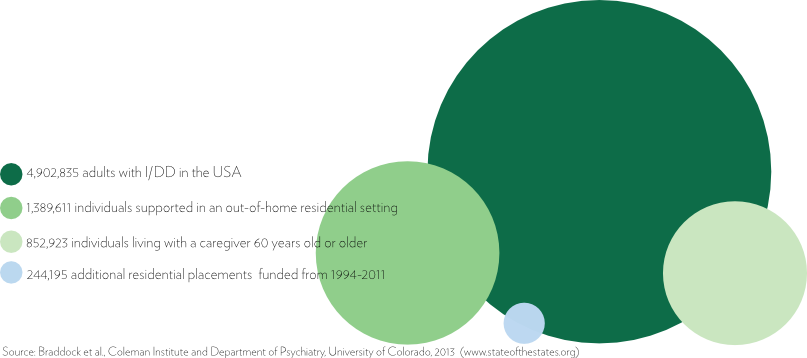
Check out your State Profile from the State of the States in Developmental Disabilities, a study that has tracked data for more than 35 years. To find residential trends in your state click here.
3. If you are lucky enough to have a waiver, be careful when considering a move out of state. Most states have long waiting lists, and you will be placed at the bottom.
It doesn’t matter if you are a military family, if your mom got a great promotion in another state, or if you fell in love with a girl across the state line – when you move, your supports do not follow you to the new state. Some states may say they do not have a waitlist, but this is not entirely true. States may not have a waitlist to get any type of support (e.g., some respite). However, every state has an undocumented waitlist for full residential supports that would allow someone with I/DD to move out of their family home. In rare cases, and usually with a hard fight, you may be able to use your state’s funding to live in a specific setting in a different state if you can prove that your state cannot provide the needed supports.
4. Families want to create more housing options but are running into barriers.
Across the country, many individuals with I/DD and their families are exploring different housing and support options in their local communities. They quickly realize that the existing options don’t align with their standards. Individuals with I/DD want to live independently with supports and housing based on their person-centered plans. They see the fluctuations in the housing market, both in rent and quality, and do not want to wait for housing vouchers that may limit their future choices if they get a job or want to move to a different county. Most importantly, they hear the stories of people with I/DD who live in their own apartments facing abuse, theft, bullying, and isolation. In response, many local communities are developing intentional communities that are built around the support needs, desired amenities, and friendships of residents with I/DD. Families are building the desperately needed housing and natural support systems that many people with I/DD desire.
Policy trends from 30 years ago, when our country rightfully began deinstitutionalizing people, now unintentionally create barriers to innovative supportive housing options. Local housing projects run into old zoning regulations that restrict people with disabilities from living in adjacent homes because, in the past, institutions purchased strings of houses and ran things as they did in the institutional settings. Now, federal Medicaid officials who hold the purse strings to waiver funding are using “guidance” to states as a way to enforce their preferences not recorded as official regulations. This “guidance” enables CMS to limit individuals from accessing waiver funding even in cases where an individual owns his home in a private neighborhood and manages his own staff using a self-directed waiver.
At the 2016 National HCBS Conference and in “guidance to states on settings that isolate” CMS defined what settings it considers isolating: disability-specific gated communities, farmsteads, residential schools, settings where people can live-work-play on the same property, campus-like settings, and intentional communities. CMS recently provided guidance on “planned construction,” revealing their bias against the development of these settings and stating that it will not give pre-approval to emerging housing communities unless they are fully operational. This process limits housing options to wealthy families who can afford to private pay up-front. It also halts the development of emerging housing communities that rely on financing because most lenders will not risk lending money to a neighborhood development that might be restricted from the potential residents they aim to serve. The state and federal government are using non-regulatory enforcement to restrict the use of one’s essential life supports and, in turn, limit housing options for individuals with I/DD. To learn more about HCBS waiver policy influencing housing choices, visit the Coalition for Community Choice website.
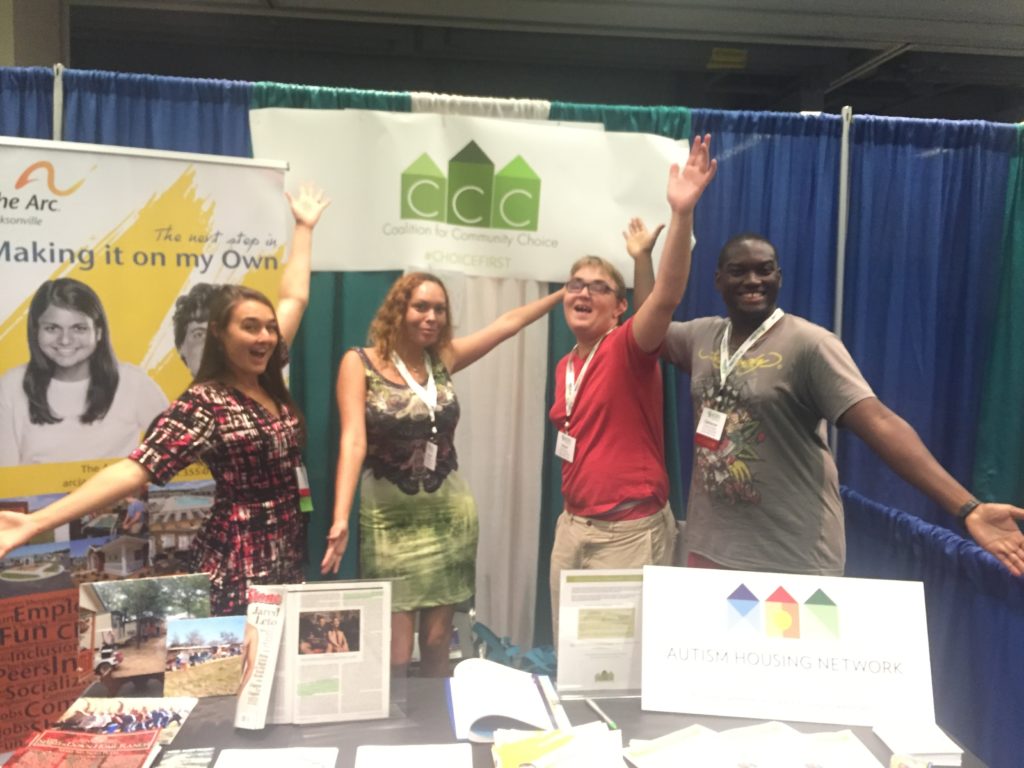
The Coalition for Community Choice table at the HCBS Conference
5. Government officials do not hear from everyday families nor recipients of publicly funded supports services with I/DD, and this impacts future housing and support choices.
Who is talking to CMS or other policymakers as they develop regulations? The most prominent voices today are paid, professional advocates in the DC-metro area. These paid advocates schedule meetings, create statements, attend government events and hearings, and sit on various task forces made up of others in the same circles. While their policy recommendations may make sense from an ideological standpoint, these ideas are often unrealistic in implementation and lacks generalizability when considering the diverse needs and preferences of individuals who utilize waivers. For example, CMS regulations on HCBS waivers requires waiver recipients to come and go from their house at any time. This is an important right for many people, but implementation of this regulation without additional funding for the wide array of waiver recipients makes the regulation simply words on paper.
Let me illustrate: For an autistic adult who can not identify the difference between his front yard and the street, leaving the house without support staff is unsafe and may put that person at risk of being hit by a car. Reimbursement of support staff may allow for only one staff person to support three individuals living in the house. Following CMS regulations, if the staff member is required to accompany one of the housemates on a walk, the two remaining housemates would be left unsupervised at home. If these housemates lived in a pedestrian-oriented gated-community, they could all walk freely in their neighborhood as cars are intentionally restricted. Unfortunately, a neighborhood of this design would be considered isolating by CMS’s standard.
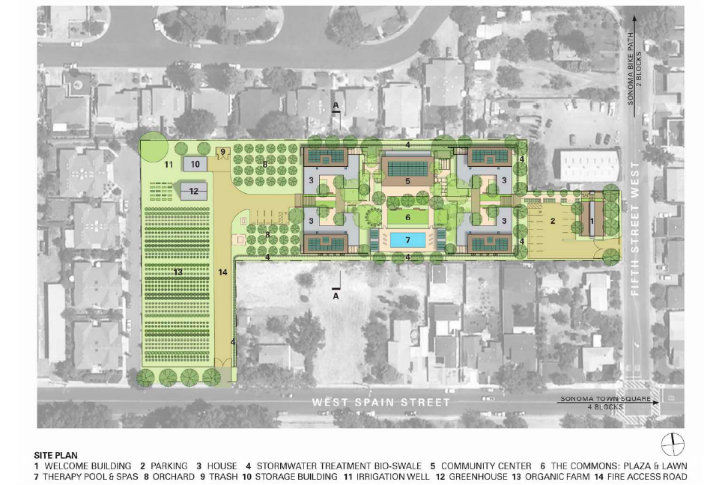

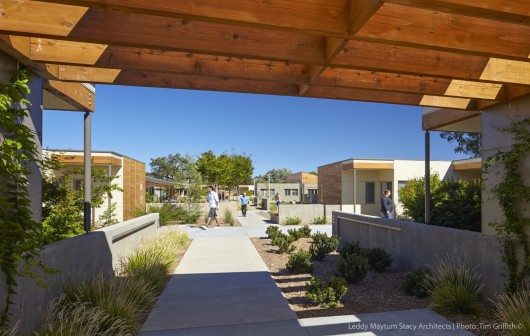 Above: Sweetwater Spectrum, a private planned community of 4 homes for 16 autistic adults that was singled out by CMS in a letter to California Medicaid authority as an example of a private setting developed to isolate individuals with disabilities. One of the residents presented with other self-advocates at the 2016 HCBS Conference to tell policymakers her home is not isolating, but innovative.
Above: Sweetwater Spectrum, a private planned community of 4 homes for 16 autistic adults that was singled out by CMS in a letter to California Medicaid authority as an example of a private setting developed to isolate individuals with disabilities. One of the residents presented with other self-advocates at the 2016 HCBS Conference to tell policymakers her home is not isolating, but innovative.
There are three federally-funded programs that have representations in each of the states and are intended to reflect the voices of people with I/DD on the ground: Developmental Disability (DD) Councils, Protection & Advocacy (P&A) Agencies, and University Centers for Excellence on Developmental Disabilities (UCEDD). Have you heard of any of these? Most individuals and families MHAF has helped are unaware as to who these entities are, how to contact them, or what they do. Yet DD Councils and P&A are given over $110 million dollars every year to represent your voice – are they?
In some states, these entities and other advocacy organizations fight against proposed housing communities. Grassroots projects are being told:
- “You are trying to create modern day institutions.”
- “People have a choice, but they can’t use HCBS funding”
- “They don’t know any better – if given another option, they wouldn’t live in a segregated setting.”
- “Intentional communities are just neo-institutions.”
- “The Olmstead decision and the ADA mandates integration.”
- “You are throwing away years of progress from our advocacy.”
As the project lead of the Autism Housing Network, I encounter these ideological barriers all of the time from people who have never even visited the communities that they vilify. I recently teamed up with other organizations in the Coalition for Community Choice to bring six self-advocates who live in intentional communities in California, Texas, North Carolina, and Florida to the 2016 National HCBS Conference. These self-advocates shared their stories and described why their choice of living on a farmstead, neurodiverse cohousing community, or other intentional community should be preserved. Check out their presentation below:
Policymakers must listen to the voices of self-advocates and their families who are experiencing the lack of opportunities, but you must speak up! Your voice is needed now more than ever as all states are in the process of creating new regulations and assessing settings in response to the HCBS Final Rule released by CMS in January 2014. Send this article to your elected officials with some of the challenges and fears you face everyday. You must make them aware of the challenges of housing choices of all individuals with I/DD. Encourage them to create incentives for the development of local public-private partnerships to create a positive future, not create barriers to local development.
Working together, the futures of five million adults with I/DD can be brighter.
If you are interested in learning more about the HCBS Conference and disability housing, join me on Friday, September 30th from 3:30-4:00PM EST on Facebook! We will be holding a AHN Live Facebook discussion about “Self-Advocacy & Housing Choice” on the Madison House Autism Foundation Facebook Page. This is a great opportunity to learn and share, so please join us with your insights!
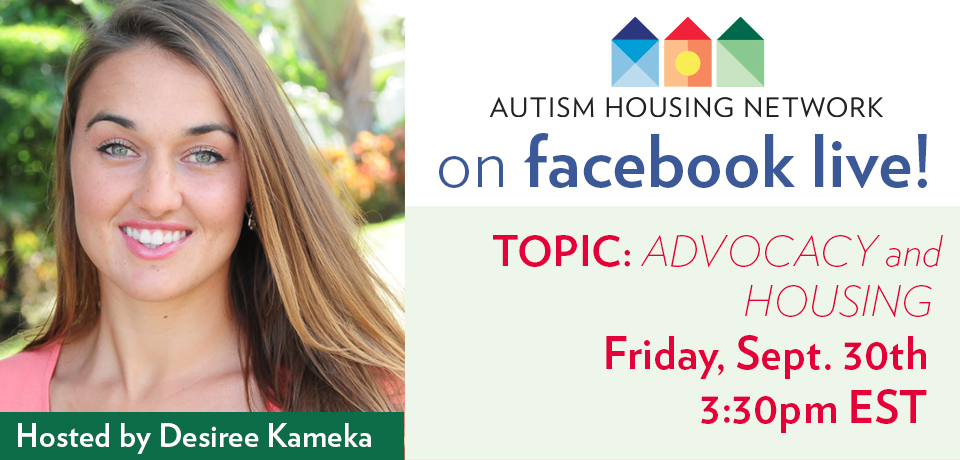


 You Aut to Know: Autism and Pathological Demand Avoidance
You Aut to Know: Autism and Pathological Demand Avoidance



Desiree,
Thank you for this informative article and for your work and advocacy to help parents and individuals access community services the way we envision….planned, supported, intentional communities. You are a guiding light to us and we are behind you all the way”
Let me know how I can support choice and freedom in settings…
Great review of challenging obstacles ahead. What do think about privatization as a means of providing people with ID/DD affordable housing? Personally I think its very risky but with wide spread underfunding of state regulatory/ advocacy agencies I think private equity firms may appear more and more appealing to states looking for ways to cut their budgets.
Thanks
Gary
I am the mother and caregiver of a 26 year old son with an autism spectrum disorder. I am very interested in your interest and advocacy for housing options for autistic adults and their future.